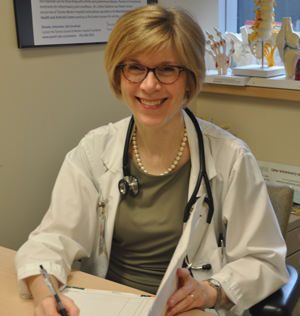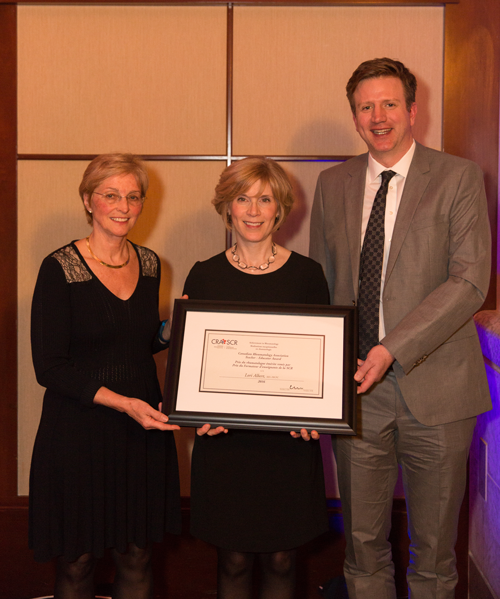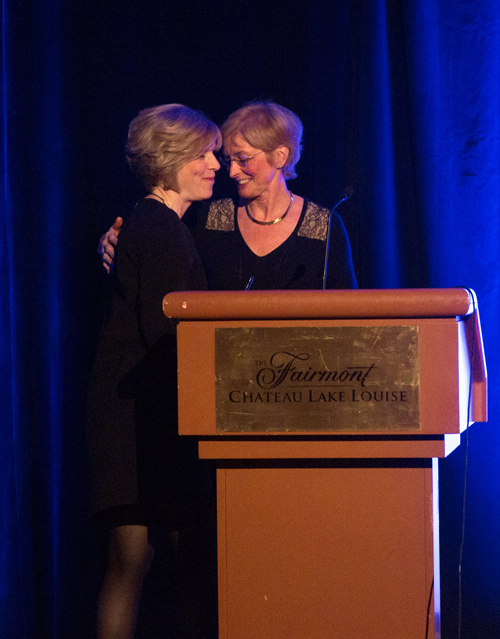Summer 2016 (Volume 26, Number 2)
Teacher-Educator:
Dr. Lori Albert
Download PDF

What do you believe are the qualities of a good educator? Moreover, how do they apply to you?
I think there are many qualities that define good educators; I have been impressed by how many different ways excellent teachers think about what they do, and how they are able to connect with and communicate with learners. I would say that some of the most important qualities—which I hope are evident in what I do—are a true enthusiasm for teaching, patience with learners (the ability to slow down and help the learner work through a problem) and a desire to see students grow and advance in their abilities and skill.
You recently edited The Canadian Clinician’s Rheumatology Handbook. What was the experience like and what was the greatest take-away from the knowledge collected?
Undertaking a national collaborative project is always a daunting prospect; however, my colleagues across the country are a tremendous group, and things got done. In some ways it was easier the second time around. I am also much happier with our second edition than the first one. I think that, having observed the first edition in use for a few years, faculty could see how to enhance and more clearly present the information in a usable way. I think reviewing and revising a body of work is always an educational
experience.
What was your inspiration behind the development of the RheumExam Atlas online platform?
There are many clinical features of rheumatic diseases that are visible to the examining physician but these are not always evident unless the clinician knows what to look for. I used to cart five different atlases to the
bedside for teaching, filled with sticky notes marking pages showing vasculitic rashes or nailfold capillary changes. After a while, my bag was not big enough to hold all of them! I also realized that there were no pictures of simple things that I take for granted, but that junior learners had never seen, such as swollen joints in the hands. I started taking my own pictures of people with early arthritis, and pictures of Patient Partners who had classic findings, so I could compare and contrast. Around that time one of my venerable colleagues gave me a huge collection of slides he had amassed over his years in practice, and I suddenly realized that I should just put together my own book with what I wanted in it. This was actually the start of the atlas.
The first print atlas turned out to be a cumbersome affair, and a little difficult to use for anyone but me. I had wanted to make something electronic for a long time. I thought an electronic atlas would make access easier, allow the atlas to grow, and be much easier to take to the bedside on a tablet platform. However, it was not until this year that I finally submitted an application to a competition for the services of a summer student from the biomedical communications program at the University of Toronto. She worked with me to develop the online
platform.

Dr. Claire Bombardier and Dr. Cory Baillie presenting Dr. Albert with her award.
Your compassion as an educator is consistently praised. Can you recall a teacher in your own past who inspired your direction into education?
There were wonderful residents who guided me—a terrified clinical clerk—through my cardiovascular (CV),
surgery, and obstetrics rotations. They taught me a lot about compassion and being learner-centred. Many
others, especially my teachers when I became a rheumatology fellow, were such outstanding educators that they really did inspire my thinking about how to be an effective teacher and the tremendous impact that has on the trainee experience. I do also particularly remember one moment during my second year in medical school: During clinical skills teaching with our group of six, my tutor, who happened to be Dr. Robert Inman, turned around from the patient he was examining, looked out the window of our 11th floor room and commented to the patient on the beauty of the late-winter sunset. That moment had a huge impact on me and gave me permission to bring humanity into teaching, when my experience as a student was that everything was very proper and regimented. Although Rob actually wanted me to become a scientist, his skill and enthusiasm as a teacher plus his ability to connect with patients and students probably did a lot more to influence my desire to be an educator!

From one great educator to another.
What talent do you have that is not utilized successfully in your workplace?
My skills in flower-arranging.
About 15 years ago you convened the first assembly
of Canadian Rheumatology Education and Learning (CanREAL). How has the educational landscape in rheumatology practice changed over the intervening years?
Rheumatology has been subjected to the same external pressures as all specialties; we have had to face reform and renewal of medical school curricula (often more than once), the introduction of CanMEDS and then CanMEDS 2015, and the impending competency-based training. We rheumatologists still sit around trying to figure out how to get more time in the curriculum and how to teach physical exam effectively! But, we also have more people who are dedicated educators and participate on a bigger scale in curricular development. Many are engaged in research in education and hold significant posts at universities, the Royal College, and in national medical education associations. I was just at the Canadian Conference on Medical Education (CCME), and there were a lot of rheumatologists there, and a lot of scholarly work by these people. So, I would say that rheumatologists have really embraced the study and practice of high-quality education, which is not all that surprising, but is a change from 15 years ago.
Given your extensive work in rheumatology education, where do you anticipate continuing medical education (CME) moving within the next decade? How do you feel the age of the internet and social media has changed the way rheumatologists approach CME programs and literature in general?
The education landscape has evolved such that we are now more evidence-based in what we do. We are more learner-centered, especially with regard to respecting the diversity of individuals and their learning styles. We think about how learning happens and not just about teaching. I think that this has, and will continue to have, an impact on CME in rheumatology. An increasing awareness of how we learn will empower physicians to better choose the learning modality that is best suited for them. Some
people will just continue to do what they have always done, but I hope that research in education will be better disseminated to the rheumatology community and will inspire people to explore different ways of educating themselves. More attention is also being paid now to the “learning continuum” and thinking holistically about our careers; this too may enable us to better map and optimize CME to meet different physician needs at different times. It is hard to imagine that we will have any better access to information than we do now, but perhaps there will be better tools for managing, processing, and appraising the mass of data that is available to us. I guess there will continue to be dinosaurs like me who do not adopt social media trends, but we will see what the next big thing is. I understand that vinyl records are making a
comeback…
If you had one free hour each day, how would you use it?
I would like to say that I would exercise or write a novel or do more volunteer work, but probably I would just sleep!

Dr. Albert teaching us how it is done!
Last year you were the inaugural recipient of the CRA Summer Student Mentorship Award. What did it mean to you to receive this honour?
Well, firstly, I was completely surprised to win this award; it had never existed before and it was the first anyone had heard about it, so it really took me by surprise. Secondly, I was unbelievably honoured. The student I worked with was exceptionally bright and motivated and we had an excellent summer together. She baked me cupcakes at the end of the summer and that was enough for me! That she went to the trouble of nominating me was really so touching and meaningful—it was a great moment overall.
What projects are you currently excited to be working on, and what projects would you like to undertake in the future?
Right now my biggest project is curriculum renewal at University of Toronto. It is taking up a lot of energy; once we are through the first year, I will start looking at other projects. I have discovered I am particularly interested in faculty development and would like to do some more learning and practice in this area.
Lori Albert, MD, FRCPC
Associate Professor of Medicine,
University of Toronto
Staff Rheumatologist,
University Health Network,
Toronto Western Hospital
Toronto, Ontario |



